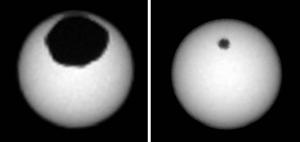Blog
Dark of the Sun
7 April 2019
 NASA/JPL-Caltech/MSSS
NASA/JPL-Caltech/MSSSA solar eclipse is a rare sight. So rare that many people go their entire lives without seeing one. It’s only possible if the Moon passes in front of the Sun in such a way that you are in the shadow. When an eclipse does occur, folks travel from all over the world to see it, and traffic in the area is a nightmare. But it turns out that solar eclipses are fairly common, and they are likely to be common all across the universe.
Eclipses are rare for particular locations. For example, my home city of Rochester NY will have a total eclipse in 2024. The last total solar in Rochester was in 1925. But if you look at solar eclipses in general, they are pretty common. At least two occur every year, and often up to four or five.
Eclipses are also common on other planets. Mars, for example, has two moons, Phobos and Deimos, and the Curiosity Rover has captured solar eclipses by both. Because Phobos and Deimos orbit Mars every 7.6 hours and 30 hours repecitvely, solar eclipses on Mars are even more common than they are on Earth.
Because of the way planets and moons form, the alignment needed for an eclipse is probably common. Planets and moons form with a young star within. a protoplanetary disk, and that means they all tend to form orbits in a similar plane. In our solar system, the orbits of eight planets are all within 8 degrees of Earth’s. Our Moon’s orbit is only tilted 5 degrees. The orbit of Phobos and Deimos are only tilted about a degree. Because orbits are in a similar plane, it’s much more likely that a moon will pass in front of the Sun.
Since other planetary systems form in a similar way, almost every planet with a moon is likely to have solar eclipses. Large moons might block the entire star for a short time, while others like Phobos and Deimos will only block a part of it. Whatever the form, eclipses are common.
But lest you think I’m downplaying solar eclipses, there is something particular special about our eclipses. Earth has a very large moon for such a small planet, and that moon is at a particularly favorable distance. For some eclipses the size and distance of the moon is such that it has the same apparent size as the Sun. So the Moon can cover the entire Sun, but not it’s thin atmosphere. At those times we can stand in the dark of the Sun and see the glowing corona surrounding the Moon.
As far as we know, that’s a sight only available on Earth.